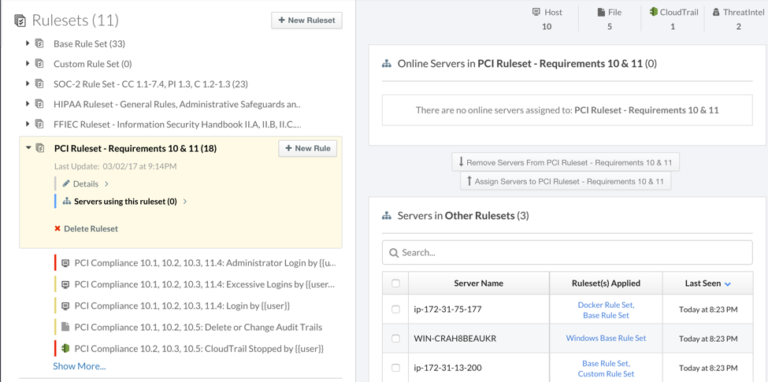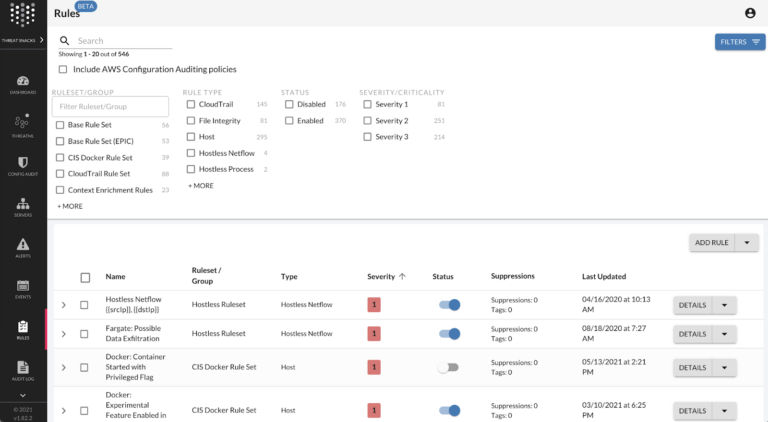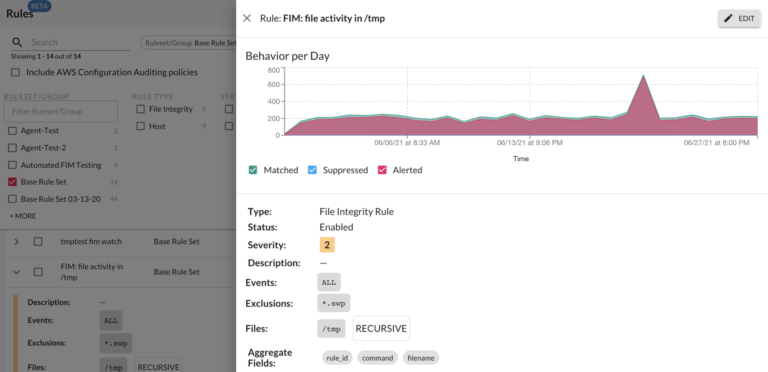1부: Threat Stack이 스마트 UI 디자인을 통해 MTTK를 줄이는 방법
Threat Stack은 이제 F5 Distributed Cloud App Infrastructure Protection (AIP)입니다. 오늘부터 팀과 함께 분산 클라우드 AIP를 사용해 보세요.
저자의 메모: 이 블로그 게시물은 Threat Stack이 사이버보안 사용 사례에 대한 UI 디자인에 어떻게 접근하는지에 대한 2부작 시리즈의 첫 번째 글입니다. 구현된 변경 사항은 혁신의 길을 계속 나아가면서 고객의 솔직한 피드백을 바탕으로 이루어졌습니다.
Threat Stack에서는 고객 피드백을 매우 중요하게 생각하며, 즐거운 도전을 좋아합니다! UI가 계속해서 현대성을 수용하는 한편, 우리는 사용자 경험을 더욱 개선하기 위해 적극적으로 구현할 수 있는 새로운 패턴과 자산을 찾고자 노력했습니다. 작년에 우리는 사용자 인터페이스(UI)에 몇 가지 반복적인 변경을 가했습니다. 우리는 핵심 구성 요소와 색 구성표를 업데이트하고, 다크 모드를 도입하고, 기능을 추가하여 사용성을 개선함으로써 사용자가 자신에게 가장 적합한 인터페이스를 통해 사고를 신속하게 감지하고 대응할 수 있도록 했습니다.
최근 우리는 조직이 감사를 가속화하고 규정 준수 요구 사항을 충족할 수 있도록 하는 플랫폼 업데이트를 발표했습니다. 이러한 개선 사항은 Threat Stack의 핵심 임무 중 하나인 규정 준수를 쉽게 달성하고 풍부한 원격 분석을 원활하게 탐색할 수 있도록 하는 것의 직접적인 결과입니다. 평균 인지 시간(MTTK)은 사용 편의성을 측정하는 데 사용되는 중요한 지표이며, 사용자가 사고를 조사할 때 모든 클릭과 키 입력이 중요하며 빠른 대응을 위해 중요합니다.
이러한 지식과 여러 고객과 주요 이해관계자의 피드백을 바탕으로, 우리는 규칙 페이지가 MTTK를 더욱 줄이는 데 매우 적합한 방법이라는 것을 파악했습니다. 또한 이를 통해 가이드 내비게이션, 머신 러닝, 데이터 시각화와 같은 새로운 개념을 도입할 수 있습니다.
오래된 것을 버리고 새로운 것을 받아들이다
제안된 변경 사항에 대해 논의하기 위해 고객 인터뷰를 실시한 결과, 기존 규칙 페이지가 의도한 목적을 충족시키고 있지만 다시 혁신할 때가 되었다는 점이 분명해졌습니다. 강력한 머신 러닝(ML) 기술을 활용한 추천 엔진, 규칙 레이블, 데이터 시각화와 같은 새로운 기능을 기대하면서 우리는 혁신된 사용자 경험을 모색할 필요가 있다는 것을 금방 깨달았습니다. 이를 통해 고객은 이러한 고급 기능을 효과적으로 활용하고 Threat Stack의 업계 최고 규칙을 탐색할 수 있습니다.
이전 규칙 페이지는 의심할 여지 없이 시대를 앞서 있었고 그 목적에 잘 부합했지만 환경을 계층적으로 보여주는 데 그쳤기 때문에 이 새로운 풍부한 맥락을 효과적으로 활용하는 과정이 복잡했습니다.

이 스크린샷은 레거시 Threat Stack UI에서 PCI 규칙 세트를 서버에 적용하는 방법을 보여줍니다.
고객 피드백의 힘
우리는 곧 출시될 새로운 기능과 기술을 여러 고객과 공유한 후 다음과 같은 핵심 요구 사항을 결정했습니다.
- 고객이 기존 규칙 데이터를 탐색하고 규칙 레이블 및 규칙 추천 엔진과 같은 새로운 원격 측정을 수용할 수 있도록 하는 측면 검색 시스템
- 조직 내에서 활성 규칙과 규칙 세트를 보다 효율적으로 전환하기 위해 규칙을 대량으로 관리하는 기능
- 여러 규칙 세트에서 규칙과 규칙 컨텍스트를 보고 중복되거나 오래된 사용자 정의 규칙을 빠르게 식별할 수 있는 기능
- 감사원에게 규정 준수 증명을 제공하는 효율적인 방법

이 스크린샷은 Threat Stack의 새로운 최상위 규칙 페이지 디자인을 보여줍니다.
이러한 핵심적인 요구 사항에 대한 우리의 해결책은 Elastic App Search를 조사하는 것이었습니다. 이 오픈소스 도구는 집계 및 강력한 검색 기능을 제공하므로, 고객이 업데이트가 필요한 규칙을 찾을 수 있습니다. Elastic App Search를 통해 이제 사용자에게 규칙 유형, 상태, 심각도와 같은 사전 정의된 필터를 제공하여 관심 있는 규칙에 집중할 수 있게 되었습니다. 또한 검색 기능을 제공함으로써 사용자는 규칙 이름에 대한 텍스트 기반 쿼리를 통해 조직의 규칙을 더욱 자세히 파악할 수 있습니다.
또한, 작년에는 테이블, 페이지 번호, 작업 버튼 등의 현대적이고 재사용 가능한 구성 요소를 생성하기 위해 구성 요소를 Material UI로 옮기는 작업도 진행했습니다. 규칙 페이지는 이러한 노력의 우선순위에 적합한 훌륭한 후보였으며, 사용자에게 더 일관된 UI 경험을 제공했습니다. 또한, 규칙 관리를 해결하기 위해 계층적 규칙 구성을 표 형태로 전환했습니다. 이를 통해 열별로 정렬하고, 여러 규칙을 선택(규칙 세트에 관계 없이)하고, 다양한 규칙 세트에서 규칙 상태를 일괄 편집할 수 있습니다.
또한 우리는 규칙에 새로운 맥락을 추가할 때 개별 규칙 보기에서 맥락을 더 쉽게 시각화할 필요가 있다는 것을 깨달았습니다. 따라서 규칙 세부 정보 페이지를 재구성하여 눈에 잘 띄는 정보를 먼저 표시하도록 했습니다. 새로 추가된 규칙 히스토그램을 통해 사용자는 선택한 규칙이 튜닝에 적합한지 여부를 빠르게 식별할 수 있습니다. 마지막으로, 규정 준수 증거를 찾고 있는 감사자와 쉽게 공유할 수 있는 읽기 전용 규칙의 기능을 구현했습니다. Threat Stack Cloud Security Platform®이 계속해서 진화하고 혁신함에 따라 UI도 진화하고 혁신될 것입니다. 이 블로그 시리즈의 두 번째 부분을 계속 주시하여 플랫폼에 대한 추가 보강이 고객의 UI 경험에 어떤 영향을 미칠지 자세히 알아보세요.

이 스크린샷은 Threat Stack의 재설계된 규칙 세부 정보 보기를 보여줍니다. 새로 추가된 규칙 히스토그램을 눈에 띄게 표시하여 사용자가 선택한 규칙이 튜닝 후보인지 빠르게 식별할 수 있도록 합니다.
Threat Stack Rules는 혁신을 계속 선도합니다.
가이드 탐색은 Threat Stack에서 다양한 UI 기능에 대해 탐구해 온 개념입니다. 규칙 페이지는 사이버보안 사용 사례에서 가이드 탐색을 조종하는 데 가장 유력한 후보로 떠올랐습니다.
그 결과, 고객은 중복된 규칙을 줄이고, 규칙 컨텍스트를 빠르게 수정하고, 규정 준수를 위해 조정이 필요한 규칙을 식별할 수 있었습니다. 새로운 규칙 페이지는 MTTK를 줄이는 좋은 방법임이 입증되었습니다. 향상된 규칙 관리를 통해 거짓 양성 반응이 감소하고 전반적인 사이버 보안 태세 유지 관리가 줄어드는 효과가 있습니다.
미래의 고려
앞으로는 규칙 메타데이터를 포함하도록 새로운 규칙 페이지를 더욱 적극적으로 활용할 계획입니다. 또한, 알림 및 서버 페이지도 비슷한 방식으로 처리될 예정이며, 고객과 협력하여 Threat Stack UI의 미래가 어떤 모습일지 계속 다듬어 나갈 수 있기를 기대합니다.
Threat Stack은 이제 F5 Distributed Cloud App Infrastructure Protection (AIP)입니다. 오늘부터 팀과 함께 분산 클라우드 AIP를 사용해 보세요.
